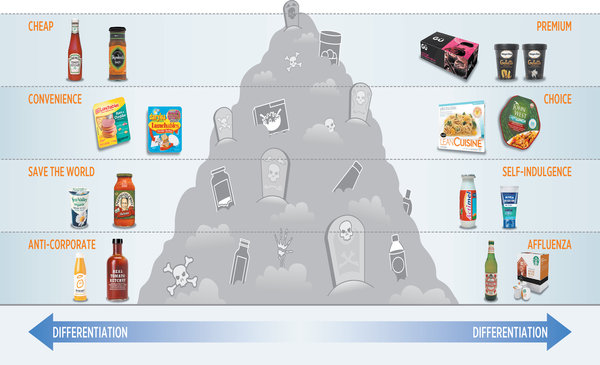Branding Strategy Insider helps marketing oriented leaders and professionals like you build strong brands. BSI readers know, we regularly answer questions from marketers and journalists everywhere. Today we hear from Kathie, Editor of Store Brand Magazine in Boston, Massachusetts who asks these questions about the state of CPG brands…
1. What are some of the most significant reasons for consumers’ waning trust in and loyalty for big CPG brands? With the advent of the Internet, people have much better access to information including product and brand reviews and feedback. Due to corruption in big government, big business and even big religion (the movie Spotlight), people’s trust in large institutions and their products and services is waning. Further, there is a movement toward “local” businesses, products and food choices.
Regarding the food category, people are increasingly opting for fresh (unprocessed) and organically grown foods with all natural ingredients. Also, consider the big brands that have disappointed people, from BP’s Gulf of Mexico oil spill and Chipolte’s e. coli outbreaks to Volkswagon’s emissions scandal and the increasing distrust of GMOs and the companies behind them. And consider the impact of well-publicized corporate inversions (avoiding US taxes by relocating overseas) on the general perceptions of large companies.
People are even so tired of a federal government that seems gridlocked and unable to meet their needs that more and more experts are writing about the power for substantive change residing primarily at the municipal level.
So, in general, people are much more apt to trust people and organizations they know locally rather than giant global corporations. Overlay these trends with the continued growth of strong store brands of comparatively equal or high quality and the difficulty of breaking through the increasingly diverse and disparate media sources to build brand awareness and preference, and one can understand what large CPG brands are up against.
Having consulted for a couple of large CPG conglomerates, it is apparent to me that at least some of the largest firms have become so systematized in their brand and project management functions that anticipating customer needs and innovating new solutions have taken a back seat to day-to-day financial management and promotions to move cases.
2. Will the big CPG brands ever recover the drawing power they had in the past? Why or why not?To win back consumers, CPG brands need to become more authentic and transparent. It wouldn’t hurt if they could stand for something important and share those important values with their customers. Tesla is doing it with environmental consciousness, as is Patagonia. Dove is doing it with its body image campaign. And Pedigree is doing it with its “We love dogs” approach to its brand.
3. What advantages do retailers have over the big brands when it comes to consumer perception?Consumers have come to love some store brands. Witness the Wegmans brand, headquartered in my hometown of Rochester, New York. Their store brand is perceived to be of high quality and they continue to selectively replace national brands with their store brand. And consumers often make their purchase decisions based on where they intend to shop first and then which brands to purchase only after they have entered the store of their choice.
4. What steps could retailers take to ensure continued loyalty and trust for both new and existing private brand products? Offer a consistently good quality and a good value. Make the store shopping experience pleasant and rewarding for their customers. And put their customers in the right mood (research has shown that happy shoppers spend more) upon entering the store by doing something to surprise and delight them at the store entrance.
5. Any other comments? Stores have the advantage of direct contact with the consumer and greater access to store sales data. They also maintain databases of consumer purchases, which can be mined for insights, especially with the emergence of big data analytics. This gives them asymmetrical consumer intelligence and interaction advantage to CPG firms.
Every brand manager must keep in mind that he or she needs to build brand awareness, relevant differentiation and emotional connection to the consumer. Brands should stand for something, they should possess strong values and they should tell compelling stories. Further, they should be very consistent in their brand cues (brand identity system elements) across products. This is what leads to strong brands.

No comments:
Post a Comment